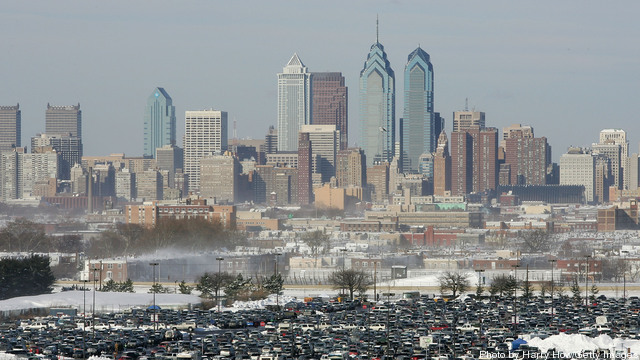
Alaska has a big vested interest in high oil and gas prices. Oil revenue accounts for 90% of the state’s tax haul. So its budget swells and oil royalties gush into a special state investment fund — the only one of its kind in the United States. And that can translate into windfalls for residents, who share in the oil bounty through annual dividends paid by the fund and, in boom times, direct payments from the state. For example, when oil and gas hit record highs in 2008, residents received $3,000 checks, twice what they normally get.
Local
Sign up and get Breaking Energy news in your inbox.
We will never sell or share your information without your consent. See our privacy policy.
I work in the basement of my senior year dormitory. This is a lot cooler than it sounds, though – just a few months after graduating from Columbia last spring in Environmental Engineering, I found myself working for a small energy consulting firm that counts my Alma Mater as one of its clients. Before heading back to graduate school to study policy next fall, I am spending time working to better understand real world operational structures and logistical constraints of addressing energy challenges. My job with a small energy consulting firm allows me to see the impact of New York energy policies on our clients’ operations and decision-making processes.
One policy, or rather set of policies, stands out: Mayor Bloomberg’s PlaNYC, in particular the Greener, Greater Buildings Plan. In my experience dealing with the energy portfolios of Columbia and our other clients (mostly hospitals) I see it succeeding for a few reasons – 1) that its requirements are ambitious, yet both achievable and desirable 2) it spurs innovation and creates new opportunities for self-sustaining growth, and 3) it is part of a broader, long-term vision for sustainability in NYC. Emphasizing a strong impact on building energy use is essential given that buildings are responsible for 75% of energy use in the city. Keep reading →

The Bonneville Power Administration (BPA), stung by a federal regulatory ruling regarding its treatment of Northwest wind power producers, is proposing new measures-including splitting the cost for lost revenue-to mollify the wind producers when an overabundance of hydroelectric power leads BPA to curtail the wind turbines in the region.
BPA sells power from dozens of federal hydro projects in the Northwest, and it controls most of the transmission lines in the region. Federal regulators in December said BPA acted unfairly in shutting off wind power in spring 2011 when a big snowmelt gave it more electricity than it said it needed. BPA’s action was opposed by wind generators, led by Portland, Oregon-based Iberdrola Renewables, many of whom lost federal production tax credits and state renewable energy certificates when their turbines were shut down and who worried that BPA’s policy could set a precedent that would stifle future support for the industry in the region. Keep reading →

Monitoring shale gas drilling has been a central technology question for oil and gas companies seeking to take advantage of huge potential reserves in the US.
“A technology to remotely monitor conditions at energy-rich Marcellus Shale gas wells to help insure compliance with environmental requirements has been developed through a research partnership funded by the US Department of Energy,” the department announced today. Keep reading →

Philadelphia Mayor Michael Nutter said on Monday the city is seeking a buyer for its publicly owned gas utility, the largest of its kind in the US, after an independent report concluded that a sale could raise several hundred million dollars for the city’s general fund.
The study by the investment bank Lazard concluded that the time is right to sell Philadelphia Gas Works because there’s good demand for strategic utility acquisitions, and because interest rates are low. Keep reading →

Pennsylvania’s newly passed bill imposing fees on natural gas drillers charges the industry far too little, doesn’t do enough to protect the environment, and was drafted in secret by Republican lawmakers who sought to curtail public debate on the measure, Democrats in the state claim.
House Democrats, who lost the decisive vote on the measure last week, argued that Republicans kept the 174-page bill under wraps until less than 24 hours before it was debated on the House floor because they were concerned that parts of it would be so unpopular among the public that it would fail to pass the legislature. Keep reading →

Pennsylvania lawmakers on Wednesday gave final approval to a bill that would impose fees on natural gas companies drilling in the state’s Marcellus Shale formation and allow the revenue to be used by local communities to offset the impact of the state’s booming shale-gas industry.
If signed into law as expected by Governor Tom Corbett, the bill will end Pennsylvania’s status as the only US gas-producing state that does not impose any kind of levy on energy companies for natural gas drilling. Keep reading →

California energy users have a shock in store between 2015 and 2020, warns a new analysis by ICF International.
That’s when California’s greenhouse gas law, the Global Warming Solutions Act of 2006, really bites. Popularly known as AB 32, the law requires progressive reductions in carbon dioxide and other gases associated with global warming, aiming to cut the state’s emissions to their 1990 level by 2020. Keep reading →

The possible permanent closure of three eastern Pennsylvania refineries would make the region more dependent on outside sources for petroleum products and force marketers to overhaul supply chains for gasoline, diesel heating oil, jet fuel and lubricants, state legislators heard on Monday.
But closure isn’t likely to have a big effect on prices or supply on the US East Coast because alternative sources such as the Gulf Coast, higher overseas imports and increased pipeline shipments from the Midwest will be found, according to a new study presented to lawmakers. Keep reading →

A collapse in oil and gas leasing on federally-owned land in six Western US states is costing the US economy jobs and federal royalties as well as limiting access to domestic energy resources, a recent oil industry backed study says.
The number of new leases issued by the Bureau of Land Management is down 44% from the 2007-2008 period to the 2009-2010 period. There was a slight uptick in leasing activity in 2011, but the American Petroleum Institute, which released the study says that much of the leasing last year was double-counting and actual new leases hit a low last set in 1984. Keep reading →
